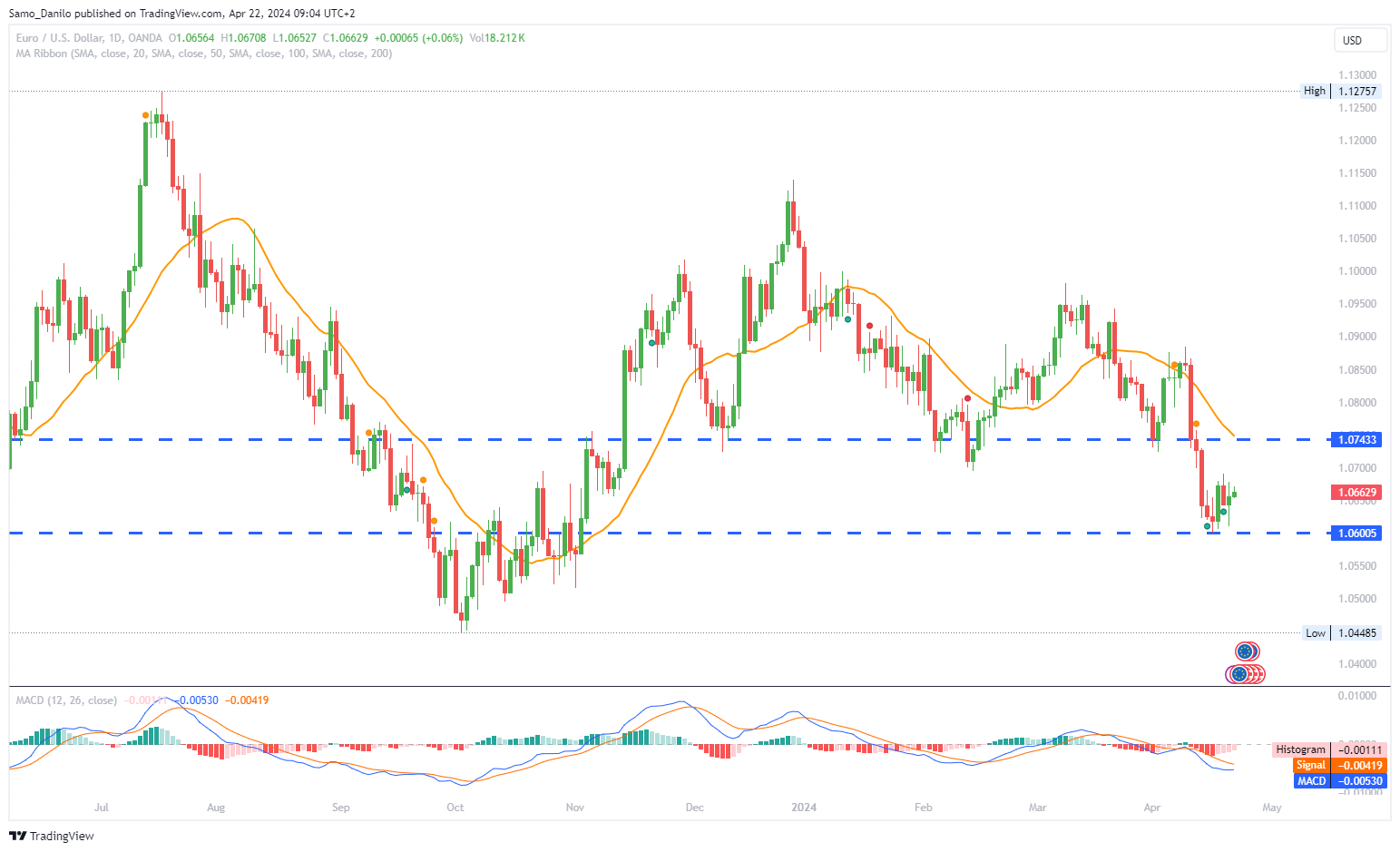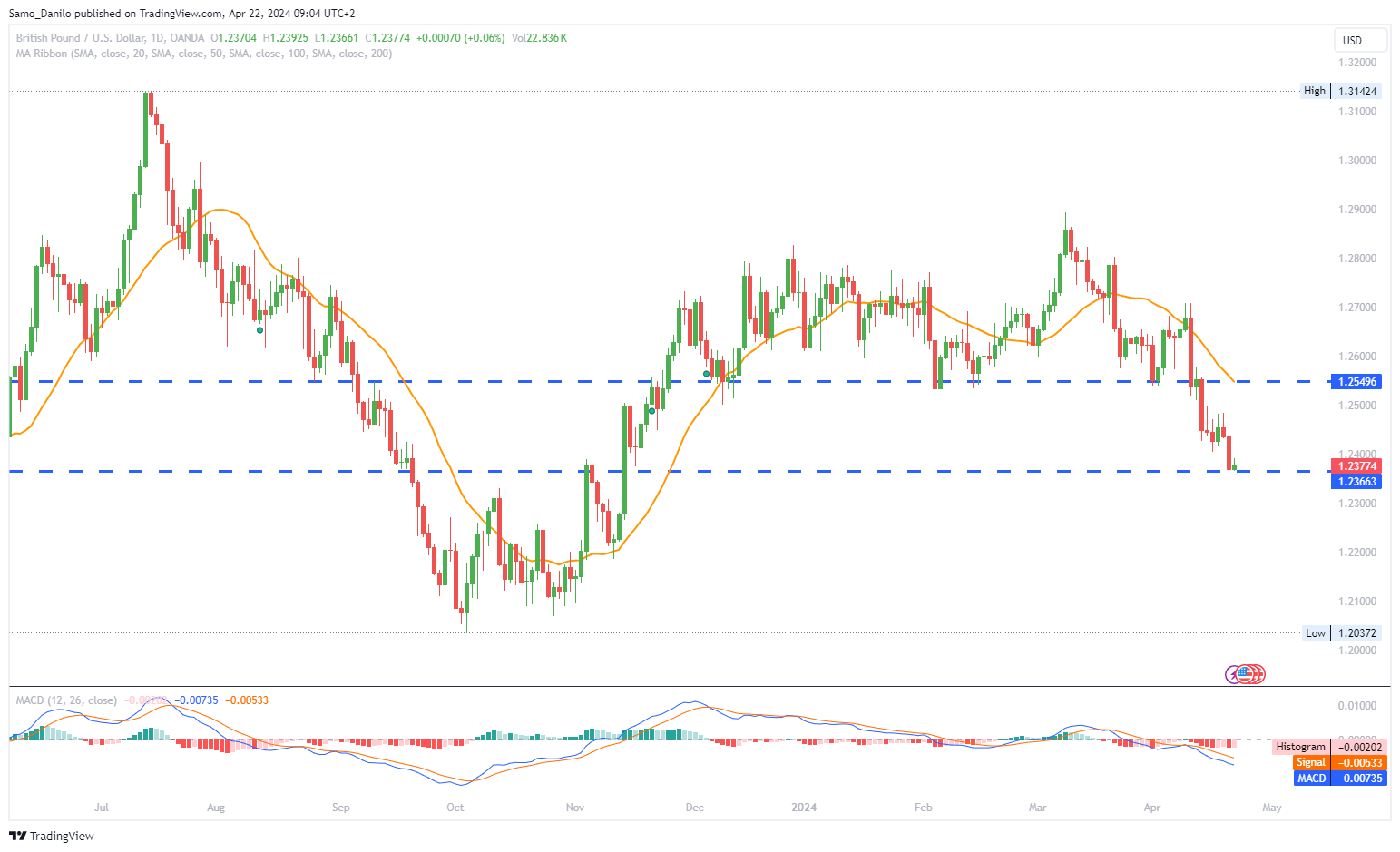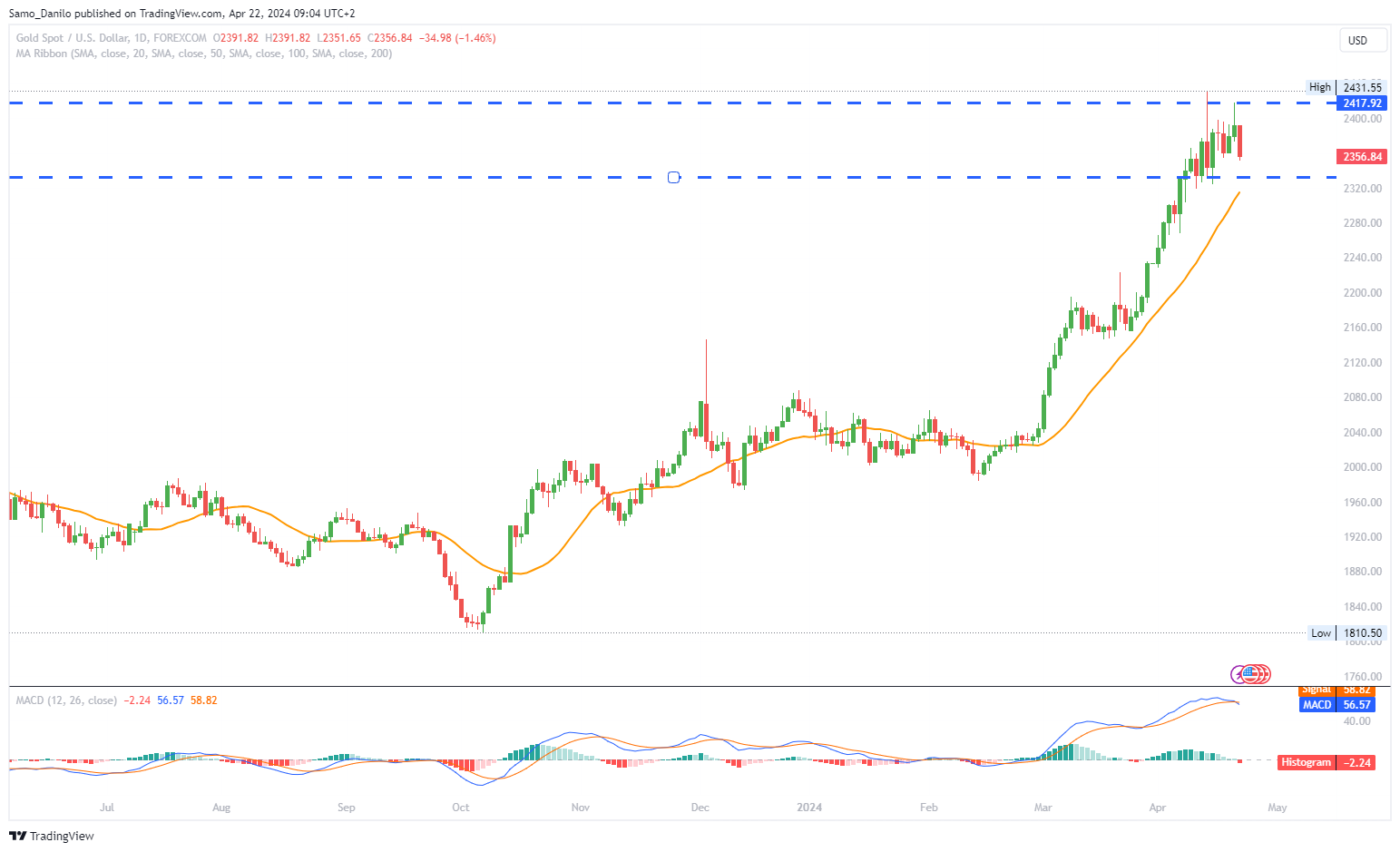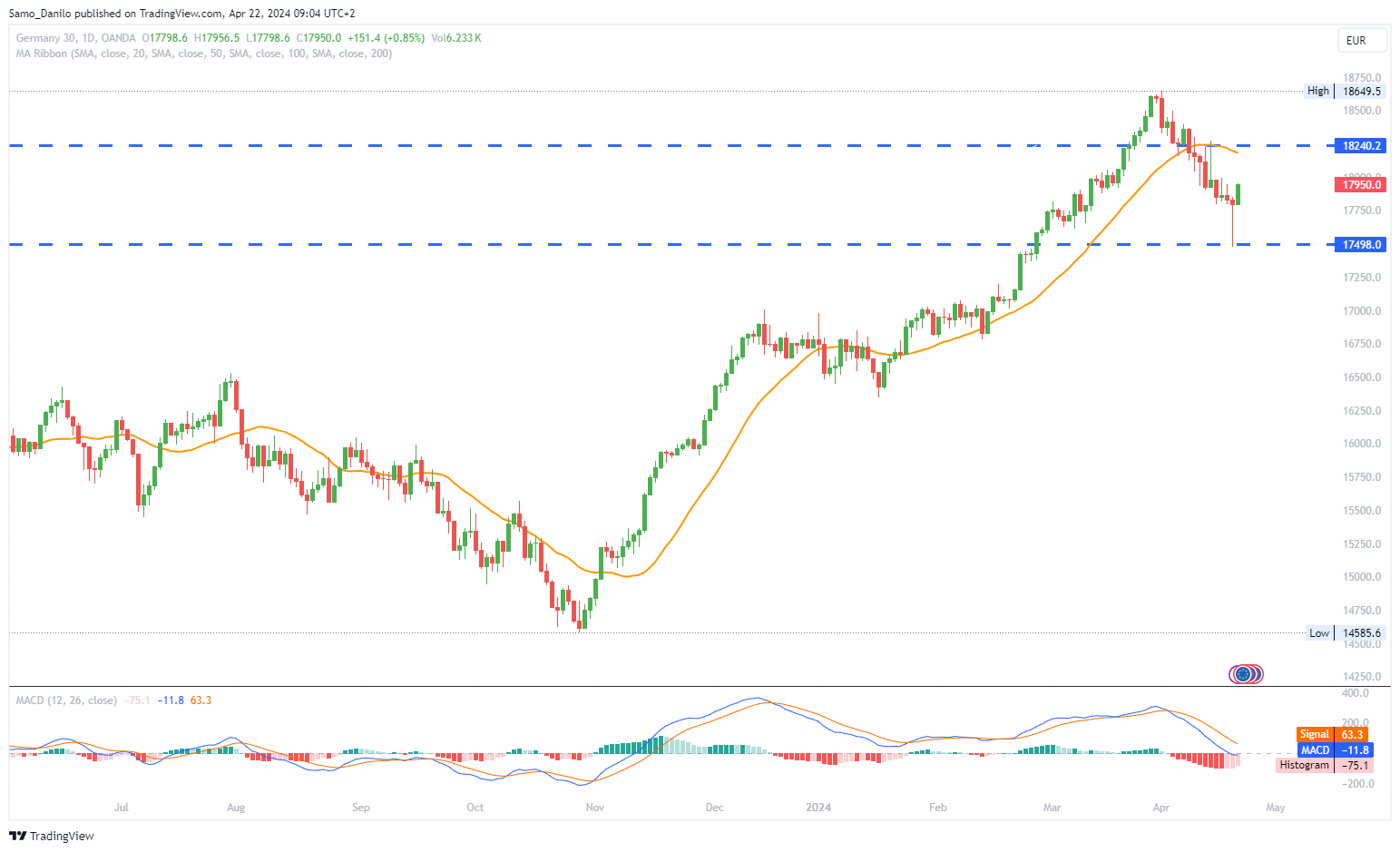EURUSD
- The EUR/USD pair exhibited strength, trading around 1.0664 during the early Asian session on Monday, supported by expectations of an imminent interest rate cut by the ECB if no major negative developments occur.
- ECB Governor François Villeroy de Galhau advocated for a rate cut in June to mitigate potential economic damage caused by higher rates, aligning with the central bank's stance on monetary policy.
- Conversely, hawkish comments from Federal Reserve officials and ongoing geopolitical tensions in the Middle East may bolster the US Dollar against its counterparts, including the Euro.
- Investors remain attentive to upcoming economic indicators, particularly the preliminary Eurozone HCOB PMI for April and the final reading of the US March Personal Consumption Expenditures Price Index (PCE) later in the week, which could influence the EUR/USD pair's direction.
Closing statement: The EUR/USD pair traded with strength amid expectations of an ECB interest rate cut in response to potential economic challenges, as emphasized by ECB Governor François Villeroy de Galhau. However, the pair faces headwinds from hawkish signals from Federal Reserve officials and geopolitical tensions in the Middle East, which may support the US Dollar. Investors are closely monitoring upcoming economic data releases for further insights into the pair's trajectory.
GBPUSD
- GBP/USD attracted some dip-buyers on Monday amid a softer US Dollar, although the pair lacked follow-through momentum.
- Market sentiment improved slightly as fears over further escalation of the Iran-Israel conflict eased, with reports suggesting a reduction in direct state-to-state strikes between the two nations.
- Expectations of the Federal Reserve maintaining higher interest rates for an extended period due to persistent inflation in the US helped limit the downside for the US Dollar, potentially capping gains for GBP/USD.
- Speculation regarding more aggressive policy easing by the Bank of England (BoE) could restrain further appreciation of the GBP/USD pair, adding to the cautious sentiment.
- With no significant economic data scheduled for release from the UK or the US on Monday, GBP/USD remained susceptible to fluctuations driven by USD price dynamics.
| SMA (20) | Falling |
|
|
| RSI (14) | Slightly Falling |
| |
| MACD (12, 26, 9) | Falling |
|
|
Closing statement: GBP/USD experienced a modest rebound on Monday amid a weaker US Dollar, although gains were limited by expectations of prolonged higher interest rates by the Federal Reserve due to persistent inflation. Improved market sentiment following reduced tensions in the Iran-Israel conflict provided some relief, while speculation of aggressive policy easing by the Bank of England acted as a potential deterrent to further appreciation of the pair. With no major economic data releases, GBP/USD remained influenced by USD price dynamics throughout the trading session.
GOLD
- Gold price drifted lower on Monday amid hopes that the Iran-Israel conflict would not escalate further, reducing demand for safe-haven assets. The decision by the People’s Bank of China (PBOC) to leave key Loan Prime Rates unchanged failed to dampen the risk-on market sentiment, contributing to the decline in demand for gold.
- A decrease in demand for US Treasury bonds led to a rise in US Treasury bond yields, exacerbating the corrective decline in gold prices as investors shifted away from safe-haven assets.
- With no significant economic data releases scheduled in the US on Monday, gold price movements were primarily influenced by risk sentiment and dynamics in the US Dollar.
- The US Federal Reserve (Fed) entered its 'blackout period' ahead of the May 1 policy announcements, limiting market-moving commentary from Fed officials. Geopolitical developments, particularly related to the Iran-Israel conflict, remained a focal point for investors.
| SMA (20) | Rising |
|
|
| RSI (14) | Slightly Falling |
| |
| MACD (12, 26, 9) | Rising |
|
|
Closing statement: Gold prices drifted lower on Monday as hopes for a de-escalation of the Iran-Israel conflict reduced demand for safe-haven assets. The decision by the People’s Bank of China (PBOC) to keep key Loan Prime Rates unchanged failed to deter the risk-on market sentiment, leading to a decline in demand for gold. Rising US Treasury bond yields further contributed to the corrective decline in gold prices. With no major US economic data releases, gold price movements were driven by risk sentiment and US Dollar dynamics, while geopolitical developments remained a key focus for investors amidst the Fed's blackout period.
CRUDE OIL
- West Texas Intermediate (WTI) oil price traded around $81.20 per barrel on Monday, hovering near its monthly low recorded on Thursday, indicating sustained downward pressure on oil prices.
- The decline in crude oil prices was attributed to eased geopolitical tensions in the Middle East, particularly following reports that Israel and Iran downplayed the risk of further escalation after Israel's strike on Iran.
- The passage of new sanctions on Iran's oil sector by the US House, reported by Bloomberg, added further downward pressure on oil prices as it could restrict Iran's ability to export crude oil.
- The expansion of secondary sanctions to cover transactions between Chinese financial institutions and sanctioned Iranian banks used for purchasing petroleum products may also impact the crude oil market, adding to downward price pressures.
- The Federal Reserve's indication that it may keep interest rates higher for longer due to concerns about persistent inflation could affect the price of oil by influencing market sentiment and demand for commodities.
| SMA (20) | Rising |
|
|
| RSI (14) | Falling |
|
|
| MACD (12, 26, 9) | Falling |
|
|
Closing statement: Crude oil prices traded around $81.20 per barrel on Monday, hovering near monthly lows amid sustained downward pressure. Eased geopolitical tensions in the Middle East and the passage of new sanctions on Iran's oil sector contributed to the decline in oil prices. The expansion of secondary sanctions targeting Iranian banks and the Federal Reserve's stance on interest rates also weighed on oil prices, reflecting broader market dynamics impacting the oil market.
DAX
- Reports of Israel retaliating against Iran's attack on April 13 initially impacted market risk appetite for DAX-listed stocks on Friday. However, subsequent news suggesting that Iran downplayed the attack eased immediate investor fears of a widespread conflict in the Middle East.
- Producer prices for March drew investor attention amidst rising expectations of a June ECB interest rate cut. While producer prices advanced by 0.2% month-on-month, the impact on ECB interest rate chatter was limited.
- ECB President Christine Lagarde's remarks indicating that inflation would likely continue to fall supported the market's anticipation of an interest rate cut.
- Eurozone consumer confidence figures for April, scheduled for release on Monday, will be closely monitored by investors. Better-than-expected numbers would align with expectations of an improving economic outlook, potentially influencing market sentiment.
- Given the market's focus on the ECB, ECB President Christine Lagarde's upcoming speech will be significant. Investors will be attentive to her comments on the economic outlook, inflation, and monetary policy, as they could affect market dynamics and investor sentiment.
| SMA (20) | Rising |
|
|
| RSI (14) | Falling |
|
|
| MACD (12, 26, 9) | Falling |
|
|
Closing statement: DAX-listed stocks navigated through fluctuating market sentiment influenced by geopolitical tensions and economic indicators. Despite initial concerns over geopolitical developments, investor sentiment stabilized amid reassurances of easing tensions. Attention remains on ECB-related events and economic data releases, with market participants closely monitoring commentary from ECB President Christine Lagarde for insights into future monetary policy decisions.




